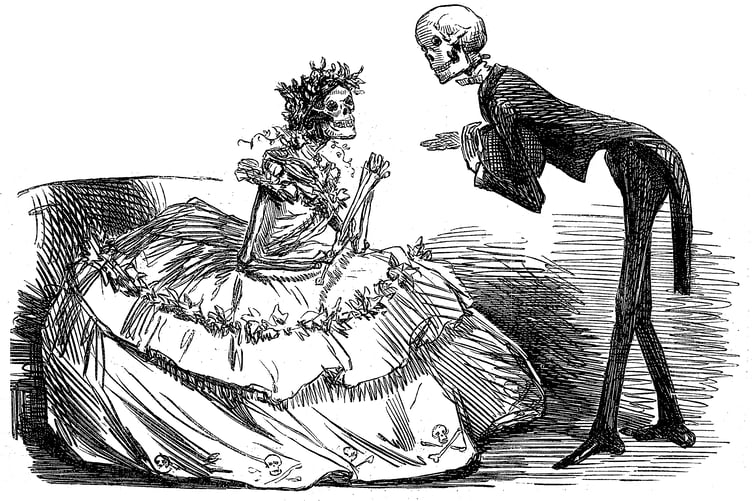HIDDEN deep within the pages of a mid-19th-century Welsh newspaper lies one of the most chilling and long-forgotten cases of domestic murders ever to emerge from the industrial South Wales valleys.
In July 1849, the magistrates in the courthouse at Crickhowell heard shocking evidence linked to a series of sudden deaths within one household, the victims being a husband and three of his young children, all believed to be victims of deliberate poisoning.
The alleged perpetrator, in a twist almost too dreadful to imagine, was the children’s own 32-year-old mother Margaret Michael who at the time of her arrest resided in a rented house near the Beaufort Iron Works where she ran a Beer shop.
During the first half of the nineteenth century, Britain was in the grip of what newspapers would later call “the arsenic panic.” The substance, cheap and readily available in shops and apothecaries, was used in everything from rat poison to wallpaper dye. Its accessibility led to hundreds of deaths, both accidental and deliberate. In many cases, suspicion fell heavily on a family member or neighbour, but prosecutions were notoriously difficult to prove. The courts demanded hard evidence, and without it, suspects often walked free, left only to face the silent condemnation of their communities.
Public alarm eventually forced Parliament to act, and in 1851 the Sale of Arsenic Regulation Act was passed to restrict the poison’s availability. Yet, tragically, that reform came two years too late for one South Wales family.
The following account drawn from contemporary Welsh newspapers in July and August of 1849 uncovers the grim details of the case: the mysterious illnesses, the whispered rumours of infidelity, and the shocking accusations that followed. Despite powerful circumstantial evidence implicating the wife and her lover, the trial would end in a verdict few in the district could comprehend - acquittal.
This disturbing episode, largely forgotten for more than 170 years, deserves to be retold — not only as a local tragedy but as a stark reflection of the dangers, injustices, and moral contradictions that haunted Victorian society.
The following newspaper report in the Welshman dated 20th July 1849 details the initial circumstances surrounding this tragic and disturbing case.
On Wednesday last, Mr. Day, Superintendent of police received from Edward Davies, Esq., Coroner, for the ‘Hundred of Crickhowell’ a warrant to apprehend one Margaret Michael, on the serious charge of having administered arsenic to her husband and three children whereby they were poisoned.
The facts of the case are as follows; About ten months ago, the deceased husband was suddenly seized, with violent sickness, but no suspicion being entertained at the time, deceased was supposed to have died from natural cause and was in due course interred.
At the time of Michael’s death, a man of the name of Ebenezer Jones, was lodging with the deceased and his wife, and it appears from evidence the deceased had on one occasion proved the infidelity of his wife with Jones, which caused great quarrels between the husband and prisoner, and shortly after the internment of deceased, Jones and prisoner had lived as man and wife.
Soon after Michael’s death, two of the children died under symptoms similar to their father, and within this last three weeks, the only surviving son William, aged twelve years died suddenly.
Suspicions having arose in the minds of the neighbours, the Coroner was informed, and he immediately issued his warrant for the apprehension of the two prisoners, and had one of the bodies, namely William examined, and the contents of the stomach being extracted by Thomas Adrey, Esq. surgeon, and by that gentleman carefully sealed and sent to W. Herepath Esq. surgeon Bristol who attended on Tuesday last at Beaufort Iron Works, where the prisoners lived, and a jury was assembled.
The proof of arsenic in the body of William Michael was clearly proved by Mr Herepath. It having now become necessary to produce evidence sufficient to establish the guilt of the prisoner, Margaret Michael.
Mr. Day, superintendent of police, with his usual zeal commenced enquiries, and succeeded with great difficulty in tracing out where the prisoner Margaret Michael had purchased the arsenic. He lost no time in producing the person at whose shop the prisoner bought the same; upon the druggist been shown the prisoner, Michael he at once identified her as the person who had purchased the arsenic at his shop.
The prisoner was thereupon committed for trial for Wilful Murder. Since the above, the body of the husband and daughter have been exhumed, and Mr. Herepath has taken the contents of their stomachs to Bristol to be analysed; the appearance of the bodies leaving no doubt they have also died from the effects of poison.
Great praise is due to Mr. Day for the exertion used in apprehending the parties, particularly in such a district as the Iron Works, where we regret to say, criminals are too often assisted in secretion from the hands of justice. The prisoner Michael was on Wednesday taken to the County Gaol at Brecon, to await her trial at the next Assizes at Brecon, and Jones is at present 'under remand.
Further testimony was provided by the accused’s landlord and landlady during the preliminary hearing held at Crickhowell.
Thomas Miles, a haulier and landlord of the house where the accused resided, described her as the mother of eight children by her late husband, who had died some ten or eleven months before the present court proceedings.
He went on to describe the circumstances surrounding the husband’s death, recalling:
“He complained of pains in the stomach and head, and was always wanting to drink, and retched violently.”
Miles added that although he had not been present when the accused’s son died, he remembered seeing the boy shortly before his illness, saying: “When I last saw him, he was suffering greatly, throwing up; he had appeared a healthy boy before his sudden illness.”
He concluded by remarking that the accused had spoken of her intention to emigrate to America with her lover, the co-accused, Jones.
Mary Miles, the landlord’s wife, gave the following evidence regarding the death of the accused’s son, William Michael:
“The boy was taken suddenly ill on the Friday and died on the following Tuesday. I saw the mother give him some broth, after which she told me that her son had been seized while taking it. He was lying on his belly on a bench, crying bitterly, and complaining of pains in his stomach and head, vomiting repeatedly. His mother went for the surgeon, who gave her two powders for the child and directions to apply a mustard poultice. He was in such pain as he could scarcely bear, and was constantly retching, throwing up a greenish substance. After his death, on the Tuesday week, his body and face were greatly swollen. His mother appeared very sorry.”
The Brecon Gazette reported that after “being locked up in their room for a long time” the jury at the Brecon Assizes on August 4, 1849 pronounced a verdict of - Not Guilty.
“When three verdicts of acquittal resulted, his Lordship then directed the prisoner to be discharged.”
As the judge’s words fell silent “the prisoner to be discharged” a stunned courtroom looked on. Though the law had set her free, she would return not to peace but to a community shrouded in suspicion, where every whispered glance would serve as its own silent verdict.





Comments
This article has no comments yet. Be the first to leave a comment.